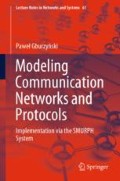Abstract
This chapter introduces tools for building and configuring the virtual hardware of a SMURPH model. That “hardware” consists of stations representing the processing units (computers) of a (distributed) system, links and/or RF channels representing the communication media, and ports and transceivers acting as taps (interfaces) to those media. We explain how those basic building blocks are put together into flexible, realistic, and powerful models of wired and wireless networks.
Access this chapter
Tax calculation will be finalised at checkout
Purchases are for personal use only
Notes
- 1.
Minus the System station (see below).
- 2.
When we say that a station becomes dormant (or active), we mean the processes running at the station.
- 3.
Technically, a segmented, unidirectional fiber optic cable can be implemented in SMURPH using repeater stations (i.e., explicit models of the interconnections of essentially bidirectional segments). The built-in unidirectional link model provides a convenient shortcut whose implementation is incomparably more efficient.
- 4.
Distance matrices do not occur explicitly (as matrices): they are distributed into distance vectors associated with ports rather than links.
- 5.
If non-standard performance measuring methods have been declared for a link (Sect. 10.3), then they will be invoked, even if the link has been created with spf = OFF . The flag only applies to the standard measures. The non-standard methods must explicitly check the flag, if they want to properly respond to its setting.
- 6.
Strictly speaking, this is the reciprocal of the rate.
- 7.
As a rule, most “set” methods have their “get” counterparts.
- 8.
SID stands for station Id, while YID means “your” (station-relative) Id.
- 9.
As we noticed in Sect. 2.4.5, the word “channel” is a bit unfortunate in this context, because we may want to model channels within a channel (Sect. A.1.2). Perhaps “medium” or “band” would better fit the role of RFChannel, except that the term “channel model” is rather well established in the literature in reference to what we have in mind.
- 10.
We remember from Sect. 2.2.5 that (wired) links can be made faulty, so some bona-fide packets may not make it to destinations because of spontaneous errors. The issue of spontaneous faults in links has been handled in a simple way (see Sect. 7.3), because such faults are usually not the most interesting part of the model. In contrast, the primary challenge in authoritative modeling of wireless channels is precisely the high-fidelity expression of errors caused by signal attenuation and interference.
- 11.
The method is a shortcut for setXTag + setRTag executed in sequence with the same argument.
Reference
P. Gburzyński, I. Nikolaidis, Wireless network simulation extensions in SMURPH/SIDE, in Proceedings of the 2006 Winter Simulation Conference (WSC ’06), Monterey, 2006
Author information
Authors and Affiliations
Corresponding author
Rights and permissions
Copyright information
© 2019 Springer Nature Switzerland AG
About this chapter
Cite this chapter
Gburzyński, P. (2019). The Virtual Hardware. In: Modeling Communication Networks and Protocols. Lecture Notes in Networks and Systems, vol 61. Springer, Cham. https://doi.org/10.1007/978-3-030-15391-5_4
Download citation
DOI: https://doi.org/10.1007/978-3-030-15391-5_4
Published:
Publisher Name: Springer, Cham
Print ISBN: 978-3-030-15390-8
Online ISBN: 978-3-030-15391-5
eBook Packages: EngineeringEngineering (R0)

